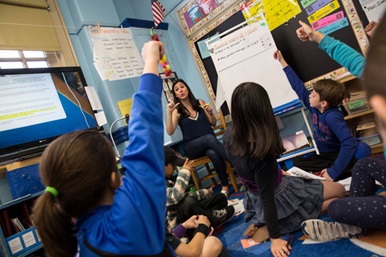
New York School Chancellor Advocates Balanced Literacy
Carmen Fariña, the new schools Chancellor has publicly announced her advocacy for Balanced Literacy—a new type of storytelling technique that aims to increase the reading comprehension skills of students. A demo held at P.S. 158 on the Upper East Side of Manhattan featured Tara Bauer, who began reading to kids from a book on sharks. A few minutes in, she hands the book to one of her students and shifts from leading the session to simply mediating between students, helping them navigate tough words and decipher more complex sentences. Balanced Literacy is one of the educational techniques which are recently being absorbed by different schools throughout the city. Carmen Fariña also stresses that this technique allows kids to choose the books which are going to be read to them—something that exercises their judgment as well as develops and defines their interests.
The New York City Education Department turned away from Balanced Literacy a few years ago, on the basis that the technique was too unstructured to succeed within the Common Core-driven type of education currently being implemented throughout NYC. However, Ms. Fariña who is a veteran in education, says that this is a big mistake: it’s only learning techniques that are open and which allow the students a certain amount of freedom to choose what they want to read and develop the skills that they’re good at (much in the “real world” scenario) that kids will be able to truly learn. In her nearly 6 months as Chancellor, she has significantly reduced the use of standardized tests. Among other changes that Carmen Fariña has implemented are more seminars and training sessions for teachers as well as an increase in parent-teacher interaction.
She says that Balanced Literacy will be especially helpful for immigrant students who may need transition reading—that way they can choose something that they understand which they can use as a jumping off point for learning to read fluently in English. She also says that more than just grammar or strict rules in spelling and punctuation, what truly helps literacy and fluency is context and interaction: something which Balanced Literacy classes will encourage. In a place like New York where a huge chunk of the population belongs to the immigrant category, this is very important. 2003 saw Balanced Literacy become a mandated policy, although it was taken down in 2007 in favor of stricter standards. Ms. Farina sights the fact that numbers haven’t gotten better, since.
Furthermore, she says that it definitely does not take away from the Common Core. Despite the fact that the Common Core is heavily standardized, the two methods have the same goal: for kids to learn in the best manner. She says that Balanced Literacy in fact, tips the scales and provides children with a holistic approach to reading and comprehension.
Lucy Calkins, a prominent teacher at the Teachers College, Columbia University says that she thinks Ms. Farina has the right steps in mind. She says that the biggest problem with how kids learn about reading (and how teachers learn to teach kids about reading) is that they implement the strict answer policy whereas with most complex works of fiction and non-fiction there is no direct answer. Instead of developing discussions and encouraging thinking about work in-depth, this kind of teaching instead encourages kids to scan books as they would questionnaires or tests, looking for answers instead of paying attention to the text and what it’s actually saying. Ms. Calkins says that while the Common Core might be more numbers-based, it is definitely not more comprehensive. In fact, she calls it myopic and focusing on the wrong things—statistics instead of actual learning.
However, Ms. Calkins does agree that these two concepts can coexist: she says that Balanced Literacy combined with the Common Core would be a way of enlarging the tent of education to accommodate the different learning styles and people who are attending schools.
 + 1-888-827-0150
+ 1-888-827-0150 + 44-20-3006-2750
+ 44-20-3006-2750









